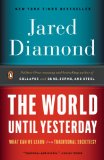Summary | Excerpt | Reviews | Beyond the Book | Readalikes | Genres & Themes | Author Bio

Critics' Opinion:
Readers' Opinion:
First Published:
Dec 2012, 512 pages
Paperback:
Oct 2013, 512 pages
 Book Reviewed by:
Book Reviewed by:
Jennifer G Wilder
Buy This Book
Why study traditional societies?
Why do we find "traditional" societies so fascinating?1 Partly, it's because of their human interest: the fascination of getting to know people who are so similar to us and understandable in some ways, and so unlike us and hard to understand in other ways. When I arrived in New Guinea for the first time, in 1964 at the age of 26, I was struck by the exoticness of New Guineans: they look different from Americans, speak different languages, dress differently, and behave differently. But over the subsequent decades, in the course of my making dozens of visits of one to five months each to many parts of New Guinea and neighboring islands, that predominant sense of exoticness yielded to a sense of common ground as I came to know individual New Guineans: we hold long conversations, laugh at the same jokes, share interests in children and sex and food and sports, and find ourselves angry, frightened, grief- stricken, relieved, and exultant together. Even their languages are variations on familiar worldwide linguistic themes: although the first New Guinea language that I learned (Fore) is unrelated to Indo-European languages and hence has a vocabulary that was completely unfamiliar to me, Fore still conjugates verbs elaborately like German, and it has dual pronouns like Slovenian, postpositions like Finnish, and three demonstrative adverbs ("here," "there nearby," and "there faraway") like Latin.
All those similarities misled me, after my initial sense of New Guinea's exoticness, into thinking, "People are basically all the same everywhere." No, I eventually came to realize, in many basic ways we are not all the same: many of my New Guinea friends count differently (by visual mapping rather than by abstract numbers), select their wives or husbands differently, treat their parents and their children differently, view danger differently, and have a different concept of friendship. This confusing mixture of similarities and differences is part of what makes traditional societies fascinating to an outsider.
Another reason for the interest and importance of traditional societies is that they retain features of how all of our ancestors lived for tens of thousands of years, until virtually yesterday. Traditional lifestyles are what shaped us and caused us to be what we are now. The shift from hunting-gathering to farming began only about 11,000 years ago; the first metal tools were produced only about 7,000 years ago; and the first state government and the first writing arose only around 5,400 years ago. "Modern" conditions have prevailed, even just locally, for only a tiny fraction of human history; all human societies have been traditional for far longer than any society has been modern. Today, readers of this book take for granted farm- grown and store-bought food rather than wild food hunted and gathered daily, tools of metal rather than of stone and wood and bone, state government and its associated law courts and police and armies, and reading and writing. But all of those seeming necessities are relatively new, and billions of people around the world today still live in partly traditional ways.
Embedded even within modern industrial societies are realms where many traditional mechanisms still operate. In many rural areas of the First World, such as the Montana valley where my wife and children and I spend our annual summer vacations, many disputes are still resolved by traditional informal mechanisms rather than by going to court. Urban gangs in large cities don't call the police to settle their disagreements but rely on traditional methods of negotiation, compensation, intimidation, and war. European friends of mine who grew up in small European villages in the 1950s described childhoods like those in a traditional New Guinea village: everybody knew everybody else in the village, everyone knew what everyone else was doing and expressed their opinions about it, people married spouses born only a mile or two distant, people spent their entire lives in or near the village except for young men away during the world war years, and disputes within the village had to be settled in a way that restored relationships or made them tolerable, because you were going to be living near that person for the rest of your life. That is, the world of yesterday wasn't erased and replaced by a new world of today: much of yesterday is still with us. That's another reason for wanting to understand yesterday's world.
Reprinted by arrangement with Viking, a member of Penguin Group (USA) Inc., from The World Until Yesterday by Jared Diamond. Copyright © 2012 by Jared Diamond.





The Flower Sisters
by Michelle Collins Anderson
From the new Fannie Flagg of the Ozarks, a richly-woven story of family, forgiveness, and reinvention.

The House on Biscayne Bay
by Chanel Cleeton
As death stalks a gothic mansion in Miami, the lives of two women intertwine as the past and present collide.

The Funeral Cryer by Wenyan Lu
Debut novelist Wenyan Lu brings us this witty yet profound story about one woman's midlife reawakening in contemporary rural China.
Your guide toexceptional books
BookBrowse seeks out and recommends the best in contemporary fiction and nonfiction—books that not only engage and entertain but also deepen our understanding of ourselves and the world around us.